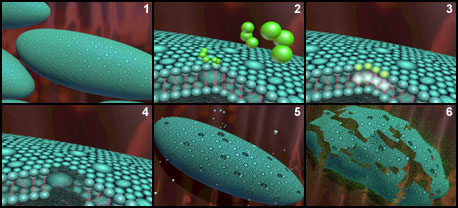Member Login
Article & Information
ADVANTAGES OF OZONE
source:http://www.ozoneapplications.com/info/advantages_of_ozone.htm
EFFECTS OF OZONE ON BACTERIA

source: http://www.ozoneapplications.com/info/bacteria_destruction.htm
BALANCING ACID/ALKALINE FOODS
| Ozone is the strongest oxidant and disinfectant available for the treatment of aqueous solutions and gaseous mixtures. | |
| Although ozone is only partially soluble in water, it is sufficiently soluble and stable such that its oxidation or disinfectant properties can be fully utilized. | |
| After ozone oxidizes or disinfects, it decomposes into oxygen | |
| Ozone reacts with a large variety of organic compounds resulting in oxygen-containing organic by-products. | |
| Although ozone is the strongest oxidizing agent commercially available, it is safe to handle. The primary reason is that it cannot be stored and, therefore must be generated and used on-site. | |
| Ozone in its gaseous phase is a proven deodorizer for a variety of odorous materials. | |
| In treating potable water, wastewater, and landfill leachate, ozone has the proven ability to convert biorefractory organic materials to biodegradable materials. As a result, combining ozone oxidation with subsequent biological treatment can produce water or wastewater with lower concentrations of problematic organic compounds more cost-effectively than either process used individually. | |
| Applying ozone to any medium (liquid or gaseous) does not add other chemicals. |
source:http://www.ozoneapplications.com/info/advantages_of_ozone.htm
EFFECTS OF OZONE ON BACTERIA

1 - Computer generated image of a bacteria cell
2 - Close-up of ozone molecule coming into contact with
bacterial wall
3 - Ozone penetrating and creating hole in bacterial wall
4 - Close-up effect of ozone on cell wall
5 - Bacterial cell after a few ozone molecules come into
contact
6 - Destruction of cell after ozone (cell lysing)
source: http://www.ozoneapplications.com/info/bacteria_destruction.htm
BALANCING ACID/ALKALINE FOODS
| FOOD CATEGORY | High Alkaline | Alkaline | Low Alkaline |
|---|---|---|---|
| BEANS, VEGETABLES, LEGUMES | Vegetable Juices, Parsley, Raw Spinach, Broccoli, Celery, Garlic, Barley Grass | Carrots, Green Beans, Lima Beans, Beets, Lettuce, Zucchini, Carob | Squash, Asparagus, Rhubarb, Fresh Corn, Mushrooms, Onions, Cabbage, Peas, Cauliflower, Turnip, Beetroot, Potato, Olives, Soybeans, Tofu |
| FRUIT | Dried Figs, Raisins | Dates, Blackcurrant, Grapes, Papaya, Kiwi, Berries, Apples, Pears | Coconut, Sour Cherries, Tomatos, Oranges, Cherries, Pineapple, Peaches, Avocados, Grapefruit, Mangoes, Strawberries, Papayas, Lemons, Watermelon, Limes |
| GRAINS, CEREALS | Amaranth, Lentils, Sweetcorn, Wild Rice, Quinoa, Millet, Buckwheat | ||
| MEAT | |||
| EGGS & DAIRY | Breast Milk | Soy Cheese, Soy Milk, Goat Milk, Goat Cheese, Buttermilk, Whey | |
| NUTS & SEEDS | Hazelnuts, Almonds | Chestnuts, Brazils, Coconut | |
| OILS | Flax Seed Oil, Olive Oil, Canola Oil | ||
| BEVERAGES | Herb Teas, Lemon Water | Green Tea | Ginger Tea |
| SWEETENERS, CONDIMENTS | Stevia | Maple Syrup, Rice Syrup | Raw Honey, Raw Sugar |
| FOOD CATEGORY | Low Acid | Acid | High Acid |
|---|---|---|---|
| BEANS, VEGETABLES, LEGUMES | Sweet Potato, Cooked Spinach, Kidney Beans | Pinto Beans, Navy Beans | Pickled Vegetables |
| FRUIT | Blueberries, Cranberries, Bananas, Plums, Processed Fruit Juices | Canned Fruit | |
| GRAINS, CEREALS | Rye Bread, Whole Grain Bread, Oats, Brown Rice | White Rice, White Bread, Pastries, Biscuits, Pasta | |
| MEAT | Liver, Oysters, Organ Meat | Fish, Turkey, Chicken, Lamb | Beef, Pork, Veal, Shellfish, Canned Tuna & Sardines |
| EGGS & DAIRY | Whole Milk, Butter, Yogurt, Cottage Cheese, Cream, Ice Cream | Eggs, Camembert, Hard Cheese | Parmasan, Processed Cheese |
| NUTS & SEEDS | Pumpkin, Sesame, Sunflower Seeds | Pecans, Cashews, Pistachios | Peanuts, Walnuts |
| OILS | Corn Oil, Sunflower Oil, Margarine, Lard | ||
| BEVERAGES | Cocoa | Wine, Soda/Pop | Tea (black), Coffee, Beer, Liquor |
| SWEETENERS, CONDIMENTS | White Sugar, Processed Honey | Milk Chocolate, Brown Sugar, Molasses, Jam, Ketchup, Mayonnaise, Mustard, Vinegar | Artificial Sweeteners |




